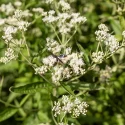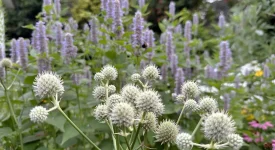Penstemon (also known by the crazy common name Beardtongue) sends up elegant stalks that are covered in a runway of flowers. Pollinators love to jump inside the flower cups. You will often see cute bee butts wiggling while they go headfirst into the blooms. There are 250+ species of penstemon native to North America and quite a few cultivars. No matter where you live in North America, there is a penstemon for you. Scroll on to meet some favorites.
- Full Sun, Part Sun
- Medium (3-5')
- Summer flowers
- Pollinator lifeline
Look out for tiny, wiggling, happy bee butts!
There are hundreds of penstemons to admire
Penstemons are perennials known for their tubular flowers, attracting pollinators like bees and hummingbirds. With around 282 species, these hardy plants can be found across various habitats, from deserts to mountain meadows. No matter where you live in North America, there is a penstemon for you.
There is even a society devoted to penstemons
Want to meet some penstemon experts, or explore this huge plant family with devotees? Head over to the American Penstemon Society, which has lots of info and events devoted to… penstemons! (Its penstemon database is a great resource.)
This plant also goes by another name…
It’s sometimes called “Beardtongue”
As you explore penstemons, you might hear this plant referred to as “Beardtongue.” And then you are going to ask:
Why is it called Beardtongue?
Some species of penstemons also go by the common name Beardtongue. This name comes from tiny, delicate hairs on the flower’s stamen. To see this “hairy tongue,” you might need to get out a magnifying glass or use the zoom on your phone.

Common names are the names that early European colonists gave to the plants they encountered in North America. Why early Americans decided to focus on a tiny detail and not its gorgeous runway of flowers is a mystery. To make sure you’re looking at the right plant, the singular Latin name helps—look for the name Penstemon on the plant label. (And no, you don’t need to learn Latin to get into gardening!)
Guess what? This is just one awful common name. Read our guide to beautiful native plants with terrible names for some other naming fails.

When do penstemons bloom?
Penstemon bloom time depends on the species and your location. According to the American Penstemon Society, “Most species bloom during March and April in the southwest United States, May and June in the mid-latitudes, June in the northern states, July in Canada, and August and September in Mexico.”
Meet some native Penstemon species
As mentioned earlier, there are hundreds of native penstemons that call North America home. This means there is a species for almost every area in America and Canada. Some species to consider adding to your garden include:
Native Penstemon species: East coast + Midwest + South

Foxglove Beardtongue
Penstemon digitalis
This plant also goes by the common names White Penstemon, Appalachian Beardtongue, Mississippi Penstemon, Hairy Beardtongue, and Foxglove Beardtongue. (Check the label for Penstemon digitalis to be sure you’ve got the right plant.) This plant’s huge native range goes from Maine to Florida, and west to Texas. Half of the USA can plant this flower!
This is a taller plant—2-5′ when in bloom with white flowers. Plant 5+ for a showstopper moment. Hairy Beardtongue is also the host plant for the Common Buckeye butterfly.
Native Penstemon species: Midwest + South

Shell-Leaf Penstemon
Penstemon grandiflorus
This plant is also sometimes called “Large Penstemon,” thanks to its larger blooms and 4′ height. Enjoy its large 2″ purple-blue flowers, and plant 5+ for maximum impact. It will self-seed in gardens, so planting a few will ensure a larger patch as the years go by. Loves full sun to part shade, and blooms for a month in the late spring. Native from Wyoming to Texas, and east to Wisconsin and Oklahoma.
Native Penstemon species - northwest

Bush Penstemon
Penstemon fruticosus
For the other side of North America, consider Bush Penstemon, which is a shorter option (6-18″). Use it as a groundcover or for xeriscape landscaping. Bush Penstemon likes full sun and its greenery is evergreen. Native from British Columbia to Wyoming.

Foothill Penstemon
Penstemon heterophyllus
The flowers on Foothill Penstemon are described as “iridescent” in The Xerces Society’s Gardening for Butterflies. Foothill Penstemons are also sometimes called Bunchleaf Penstemons. They are beloved by all pollinators—including hummingbirds.
Wasatch Beardtongue
Penstemon cyananthus
Wow, this native plant can thrive in some dry, and tough conditions. Wasatch Beardtongue has a Northwestern native range that includes Idaho, Utah, and the Dakotas.
Build It, Grow It has a helpful overview video of Foxglove Beardtongue, which includes helpful landscaping inspiration:
What are good pairings for penstemons?
There are SO MANY native plants that are stellar pairings for penstemon flowers. A good rule of thumb is to pick partners that flower at different times, so your garden looks great throughout the growing season and pollinators always have a snack. Find your region and explore options for native flowers, shrubs, and trees:
Feeling a little overwhelmed picking native plants?
Gardening should be fun and not feel like a botany exam. If you’re feeling overwhelmed as you plan your native garden, check out our inspiration guides. They are all written to help get you gardening (and not worrying.)
To make garden planning easy: Three-Color Native Gardens and Single-Plant Native Gardens are great resources.
Or, if you’re looking to focus on a specific butterfly or bird (or keep deer away!), visit Best Native Plants for Birds, Best Native Plants for Butterflies, and Deer-Resistant Native Plants.
Remember: native plants plant themselves. If they can do it, so can we.
And to sum it all up—penstemon is a huge plant family that includes options for everyone in North America. They are great alternatives to non-native snapdragons or petunias. Because penstemons are perennials, plant once and they will return year after year. Their wide range of sunlight makes them a perfect choice for beginner gardeners. And don’t forget to plant other plants that hummingbirds like, if you’re into that sort of magical thing. Happy planting!
Sources
- American Penstemon Society
- North Carolina Extension, Gardener’s Toolbox: Penstemon
- USDA Plants Database, Bush Penstemon
- USDA Plants Database, Wasatch Penstemon
- Taylor, Patricia A. Easy Care Native Plants. (1996), 174-175, 266-267.
- Nelson, Gil. Best Native Plants for Southern Gardens: A Handbook for Gardeners, Homeowners, and Professionals, (2010).
- Harstad, Carolyn. Go Native! Gardening with Native Plants and Wildflowers in the Lower Midwest. (1999), 209-210.
- Pyle, Robert Michael. Gardening for Butterflies: How You Can Attract and Protect Beautiful, Beneficial Insects. (2016), 119.














